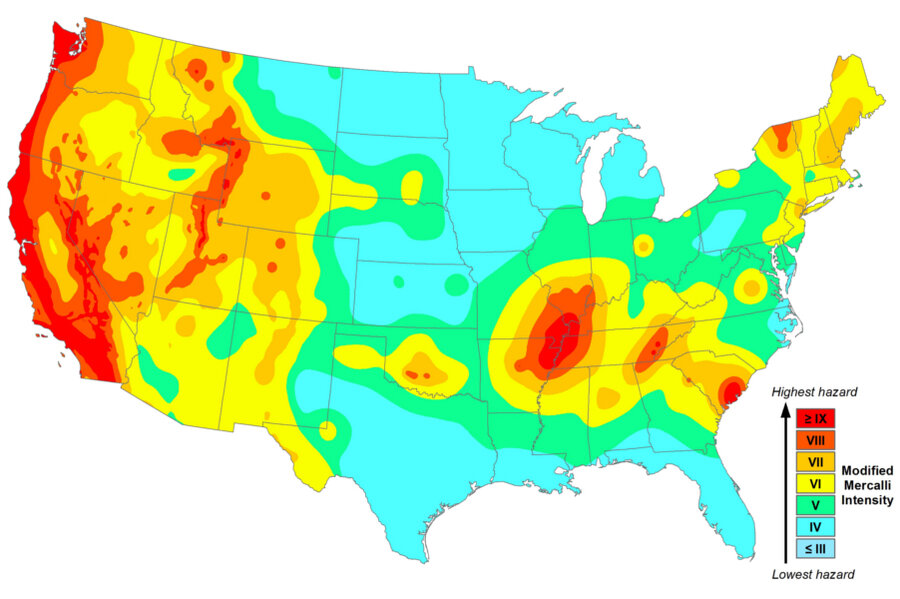Do you live in an area prone to quakes? You might be surprised.
Loading...
The number of earthquakes shaking the US has been on the rise in recent decades, and now nearly half of all Americans now live in earthquake-prone areas, according to a recent study by the US Geological Survey (USGS) published in the journal Earthquake Spectra.
More 143 million people in the 48 contiguous states are likely to face "potentially damaging ground shaking" caused by earthquakes, and after adding those living in vulnerable regions in Alaska, Hawaii, and the US territories, this number rises to about half of all Americans.
"The new exposure estimate is nearly double the previous 2006 estimate of 75 million Americans in 39 states, and is attributed to both population growth and advances in science," said William Leith, the USGS senior science advisor for earthquake and geologic hazards and a co-author of the study.
"Populations have grown significantly in areas prone to earthquakes, and USGS scientists have improved data and methodologies that allow for more accurate estimates of earthquake hazards and ground shaking."
The USGS found that approximately 57 million people live or work in areas where the kind of shaking that destroys buildings can be expected to happen at "moderately frequent intervals," or once every 475 years. This translates into a 10 percent probability of occurring within 50 years.
According to the study, 28 million people live in locations with building-destroying quakes expected at "relatively frequent intervals," with a 50 percent probability over 50 years.
Scientists came up with these estimates by considering the likelihood of an earthquake happening within a 50-year time frame, the typical lifetime of a building before it becomes unsafe. They also looked at recently updated US National Seismic Hazard Maps that predict the location, frequency, and intensity of future earthquakes.
So who faces the highest risks?
The west coast, the "intermontane" region between the Sierras and the Rockies, and several "active" regions of the central and eastern US are particularly susceptible to earthquake hazards, the researchers say. The 10 most populated states prone to very strong quakes are California, Washington, Utah, Tennessee, Oregon, South Carolina, Nevada, Arkansas, Missouri, and Illinois.
The USGS says several factors influence the severity and aftermath of an earthquake, including the location of fault lines and an area’s seismicity rates. While most quakes won’t lead to intense shaking, the ones that do "could cause significant damage and casualties," say USGS scientists.
"Of particular concern is the significant amount of critical infrastructure located in high earthquake-hazard areas, ranging from private and public schools to health care facilities and fire stations," said Kishor Jaiswal, a USGS research structural engineer and lead author of the study.
Central and eastern states have seen a sharp rise in earthquakes over the past few years, note scientists.
Between 1973 and 2008, the region experienced about 21 earthquakes per year with magnitudes of three or higher, according to the USGS. That rate rose to an average of 99 quakes per year in 2009-2013, and is likely to soar in the near future – 2014 alone saw 659 magnitude-three or higher earthquakes.
The spike is due to a rise in "induced" earthquakes, say USGS scientists, meaning quakes caused by human activity – usually fracking, enhanced oil recovery, saltwater disposal, or wastewater injections. Two April studies found that typically dormant areas, far from fault lines, have become exposed to these “man-made earthquakes,” as The Christian Science Monitor's Henry Gass reported at the time.
In line with those findings, two studies published in June found that “high-rate injection wells,” those that injected more than 300,000 barrels per month into the ground, have also contributed to the skyrocketing rates of earthquakes.
Of course, not all fracking sites or injection wells shake the ground enough to notice, note Justin L. Rubinstein and Alireza Babaie Mahani, with the USGS and the Geological Survey of Canada, respectively.
"Most injection wells do not cause felt earthquakes," they wrote in June. "There are approximately 35,000 active wastewater disposal wells, 80,000 active enhanced oil-recovery wells, and tens of thousands of wells are hydraulically fractured every year in the United States. Only a few dozen of these wells are known to have induced felt earthquakes."
Fracking gets a disproportionate share of they blame, they argue. "Wastewater injection is associated with all of the largest injection-induced earthquakes," they write. Even though the US has approximately 30 times as many fracking wells as wastewater disposal wells, the US has had "only three reported cases of hydraulic fracturing-induced earthquakes ... and only a few more worldwide," they note.
"This new research helps us better understand the scale of earthquake hazards," says the USGS's Dr. Jaiswal, "and ultimately strengthen the nation’s ability to protect Americans against future events."









